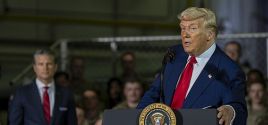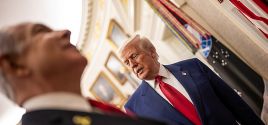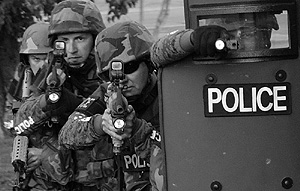Reading the Road Map to a Police Stateby Aaron TaoThe Independent Institute Oct. 20, 2014 |
Popular 
Report: Hamas Says Witkoff Promised to Lift Gaza Blockade in Exchange for Edan Alexander

Ben Shapiro, Mark Levin and Laura Loomer Warn of Foreign Influence... From Qatar

Eloy Adrian Camarillo, 17, Arrested in Shooting Death of Infowars Reporter Jamie White

NYT: Trump Ended War With Houthis After They Shot Down U.S. Drones, Nearly Hit Fighter Jets

Trump Advisor to Washington Post: 'In MAGA, We Are Not Bibi Fans'
 "There is no crueler tyranny than that which is perpetuated under the shield of law and in the name of justice." —Charles de Montesquieu If there was any silver lining to the horrifying events that took place in Ferguson, Missouri which riled the month of August, it has finally brought the issue of police militarization to the forefront. As outrageous as the police shooting death of unarmed 18-year-old Michael Brown was, the brutal law enforcement response in the form of running roughshod over the First Amendment and resorting to quasi-martial law to mostly peaceful protests by local residents and activists was worse. To many observers, what took place in a Midwest suburb was indistinguishable from scenes out of occupied Iraq.  How did this happen? For an answer, the writings of investigative journalist Radley Balko are an invaluable resource. Perhaps more than any other person, Balko has reported substantially on police militarization and injustice across the country for years. The full details can be found in his book Rise of the Warrior Cop: The Militarization of America's Police Forces . This important book, which was recently released in its paperback edition, could not have arrived at a better time. Despite going into an intellectually rigorous analysis of law, politics, and history, Balko has a gift for storytelling, which highlights many heartbreaking stories and makes Rise of the Warrior Cop an accessible and gripping read. In the introduction, Balko begins with the provocative question: How did we evolve from a country whose founding statesmen were adamant about the dangers of armed, standing government forces — a country that enshrined the Fourth Amendment in the Bill of Rights and revered and protected the age-old notion that the home is a place of privacy and sanctuary — to a country where it has become acceptable for armed government agents dressed in battle garb to storm private homes in the middle of the night — not to apprehend violent fugitives or thwart terrorist attacks, but to enforce laws against nonviolent, consensual activities?In the first chapter, Balko traces classical history and its lessons on America’s Founders as well their own experiences under British rule. As students of the Enlightenment, they were familiar with how the Roman Republic was overthrown by ambitious military leaders and how the Praetorian Guard in the Empire era, which not only acted as bodyguards for the emperor but also took on many policing roles as well, was responsible for much political intrigue and instability. In the lead-up to the American Revolution, British authorities used the hated writs of assistance to enforce tax laws and to crackdown on contraband in the colonies. This type of general warrant allowed for authorities to “search broad groups of people, for evidence of any number of crimes, sometimes over long stretches of time.” As bad as they were, Balko noted that in contrast to what police can do today, the writs of assistance could not be exercised at night and they required a knock-and-announcement before entry into a private home. Finally, it was the deployment of British soldiers to enforce the law that brought long-simmering tensions to a boil. After the Revolutionary War, with these abuses still fresh on their minds, the Founders framed and ratified a Constitution with a Bill of Rights. The Fourth Amendment, in particular, was written explicitly to prohibit general warrants and to reinforce the Castle Doctrine, an even older principle carried over from the British common law that can be traced back to antiquity. The Castle Doctrine simply reinforces the timeless idea that "a man’s home is his castle." As explained by Balko: Implicit in the sentiment is not only the right to repel criminal intruders but also the idea that the state is permitted to violate the home's sanctity only under limited circumstances, only as a last resort, and only under conditions that protect the threshold from unnecessary violence. Thus, before entering without permission, government agents must knock, announce and identify themselves, state their purpose, and give the occupants the opportunity to let them in peacefully. … The announcement requirement under English law was not a formality, as it has become in police raids today. It was elemental. Its purpose was to give the homeowner the opportunity to avoid violence, distress, and the destruction of his property.Balko also goes into interesting detail regarding the Third Amendment, the "runt piglet of the Bill of Rights," which contains the seemingly antiquated provision that prohibits the quartering of soldiers in private homes. The case law pertaining to the amendment is scant but Balko asks us to consider why the Founders placed such an importance on it. Read in light of the Castle Doctrine, it makes sense that those who revere the principle that "a man’s home is his castle" would not tolerate their homes being occupied by soldiers. But most importantly, "the amendment was a placeholder for the broader aversion to a standing army. … It represented a long-standing, deeply ingrained resistance to armies patrolling American streets and policing American communities." Until the Civil War and Reconstruction, active duty troops were rarely if ever used for domestic law enforcement. In the early American republic, law enforcement was left mostly in private hands. Close-knit communities with shared values relied mostly on social stigma and shaming to maintain order. Professional full-time prosecutors didn’t exist, and it fell upon crime victims themselves to initiate the charges before a grand jury, a panel of private citizens who had the power to indict. The citizen militia was called out for only the worst cases that required force. But as urbanization advanced and an increasingly diverse population grew, it brought the need for changes. One particularly interesting historical fact noted by Balko is that after the fall of Rome, centralized metropolitan police forces were not to be formed for almost another two millennia. In places that developed strong civil liberties traditions such as England and the American republic, people remained suspicious of standing armies, martial law, and powerful executives. In the United States, the New York Police Department (NYPD) was not formed until 1845. Modeled after London’s famous "bobbies," political leaders had to wage major public relations campaigns to win over the trust of citizens. Major efforts were taken to distinguish the police from soldiers, and to ensure they were responsive to elected officials and the public. But in many jurisdictions, the police became a little too responsive to politicians, acted as corrupt henchmen for anyone who won office, and oppressed minorities and outsiders. The issue of police corruption was serious enough that it became a plank in the progressive movement by the early twentieth century. Reformers introduced the concept of professionalism which "transformed the job of police officer from a perk of patronage to a formal profession with its own standards, specialized knowledge, and higher personnel standards and entry requirements." Although it helped address the problem of corruption, this new policy began to subtly separate the police from the communities they supposedly served and protected. The meat of Balko’s story focusing on police militarization began in the 1960s. During this time, the civil rights, antiwar, and counterculture movements became very active while the overall crime rates soared. As the liberal Warren Court expanded the rights of the accused in a number of notable rulings, the law-and-order types became greatly alarmed that society was falling apart. As his critics on the right continued their attacks that he was "soft" on crime, President Lyndon B. Johnson oversaw the creation of two government institutions to fight crime that would have huge future ramifications: This would go on to set a large precedent for future programs like Byrne grants and the Pentagon’s 1033 program as "Johnson’s successors would quickly discover that introducing a funding spigot like LEAA, then threatening to pull it away, was an effective way to persuade local police agencies to adopt their preferred polices." The modern War on Drugs would officially begin under President Richard Nixon after winning on a law-and-order campaign and appealing to the “Silent Majority.” The focus of the Nixon’s administration’s anticrime effort would be on drugs, which they thought was the common denominator among racial minorities, the counterculture, and the antiwar movement that alienated “ignored America.” The Nixonites pushed for massive funding for the BNDD and LEAA, demanded no-knock warrants for federal drug agents, and even temporarily shutdown the U.S-Mexican border in Operation Intercept. In 1969, the first SWAT raid was carried out in Los Angeles against the Black Panthers. Despite the raid being a disaster "practically, logistically, and tactically," it was a major success in public relations and SWAT teams would spread to nearly every city in America in the following decades. Despite being originally designed for emergency situations where violence was needed to end violence such as bank robberies and hostage scenarios, mission creep was unavoidable and SWAT teams would go on to be used for everything from breaking up neighborhood poker games, enforcing underage drinking laws, and performing regulatory inspections, as meticulously documented by Balko. Fast forward to modern day, it is now estimated that SWAT raids occur up to 40,000 times per year across the United States. This can be traced back to the Reagan administration when SWAT tactics began to be increasingly used in fighting the drug war. Hardliners in his administration saw a "biblical struggle between good and evil, and in the process turn[ed] the country’s drug cops into holy soldiers." Noting the inconsistent reverence supposed limited government conservatives have for Reagan, Balko had this to say: Conservatives had always held the somewhat contradictory position that government can’t be trusted in any area of society except when it comes to the power to arrest, detain, imprison, and execute people. But Reagan didn't dance around the contradiction, he embraced it. He blamed crime on big government — and in the same breath demanded that the government be given significantly more power to fight it.Under Reagan, the FBI was brought into enforcing drug laws, health professionals who favored treatment for drug abusers were purged from the bureaucracy, and sweeping new policies such as civil asset forfeiture (the legal theory that property itself can be guilty of a crime and be seized without the owner even being charged) were embraced. Perhaps the most radical action was that Reagan sought to amend the Posse Comitatus Act and bring the military into the Drug War. Balko notes that: By the end of the 1980s, joint task forces brought together police officers and soldiers for drug interdiction. National Guard helicopters and U-2 spy planes flew the California skies in search of marijuana plants. When suspects were identified, battle-clad troops from the National Guard, the DEA and other federal and local law enforcement agencies would swoop in to eradicate the plants and capture the people growing them.After Reagan was succeeded by Vice President George H.W. Bush, the same course continued. Bush Sr. appointed hardliner Bill Bennnet (who once called for beheading drug dealers on Larry King live and even "urged children to turn in their friends who used drugs to the police") as drug czar and ramped up rhetoric that the drug war was a moral crusade between good and evil. Drug treatment programs were stripped of funding, while additional cash flowed into law enforcement and new prison construction. Perhaps the most significant were the Byrne grants that were created in a 1988 crime bill which would send billions in federal cash to police departments over the next twenty-five years and allow "the White House another way to impose its crime policy on local law enforcement." But in Balko’s view, the program's most harmful legacy was the "creation of hundreds of regional and multijurisdictional narcotics task forces" that were often unaccountable and financially rewarded for making many busts in the following decades. Reformers and activists hoped the election of Bill Clinton would bring changes to the War on Drugs but sadly, that would not be the case. Instead, Clinton "encouraged paramilitary raids against low-level offenders — even users" and cracked down hard on medical marijuana facilities in order to send a political message despite legalization in a number of states. In addition, the Bryne grants picked up steam as they incentivized "police departments across the country to prioritize drug crimes over other investigations." Perversely, the funds were awarded based on the "number of overall arrests, the number of warrants served, or the number of drug seizures." As a result, actually reducing crime was not favored and instead, grants were given to police departments that were making lots of seizures regardless of size and easy arrests (e.g., low level drug offenders). During this time, the Supreme Court continued to whittle away the Fourth Amendment and further militarization was promoted through the creation of infamous 1033 program as relationships between the federal government and local police departments deepened. High-profile tragedies in the 1990s involving heavily militarized law enforcement such as Ruby Ridge and the Waco Siege served mostly as partisan fodder as the right temporarily became critics only to fall silent when George W. Bush became President. Bush Jr. followed the moral crusade script and continued the paramilitary raids against medical marijuana facilities and patients despite some initial lip service to federalism. After the September 11th terrorist attacks, drug warriors did not fail to waste a good crisis and used the opportunity to attempt to link the new fear of terrorism to drug use. In addition, the new War on Terror created another "ratchet effect" that ballooned an already-growing National Security State and furthered militarized the police. Thanks to generous anti-terrorism grants from the Department of Homeland Security which dwarfed even the 1033 program, police departments across the country upgraded their arsenals with automatic weapons, drones, armored vehicles, and other military equipment. But since terrorist attacks are incredibly rare, police used their new gear for drug raids instead. Meanwhile, the Supreme Court continued its siege on the Castle Doctrine and the Fourth Amendment with its decisions in United States v. Banks and Hudson v. Michigan. Many people desiring "hope and change" put their faith in Barack Obama for a drug war détente and an overall repudiation of the Bush policies, but as with what happened with Clinton, they were in for a very bitter disappointment. Obama expanded the trend of police militarization by pouring a record $2 billion into the Byrne grants. This was part of his 2009 economic stimulus package, overseeing "more federal raids on marijuana dispensaries in four years than George W. Bush had presided in over eight," promoting greater forfeiture takings by the Justice Department, and continuing to give away hundreds of millions in federal surplus military equipment to local and state police departments. Near the end of the book, Balko offers a number of proposed reforms to rollback police militarization and restore the workings of a free society. These ideas include the practical as well as politically unattainable, but at very least, provide a working road map: Even as more people awaken to the realities of a growing police state, the challenges to restoring a free society are vast and likely to be resisted every inch of the way by entrenched interests. As Abigail Hall and Christopher Coyne pointed out in their political-economic analysis of police militarization in the Spring 2013 issue of The Independent Review: Government agencies’ inherent tendency is to expand beyond their designers’ initial aims and goals. Special-interest groups exacerbate this problem by seeking to expand their power and influence. The onset of crises — whether real or manufactured — begins a long, far-reaching process that erodes the already imperfect constraints on the government’s power … citizens must become skeptical of the possibility of establishing permanent constraints on government power. This skepticism ultimately requires recognition and appreciation of the realities of government power and a rejection of government action as a solution to the perceived crises.After reading through Rise of the Warrior Cop, if there be a single lesson we should grasp, it is that police militarization and the War on Drugs are intimately tied. The former cannot be reversed unless the latter is ended. Thanks to the War on Drugs, the Castle Doctrine crumbled, the United States ended up with the largest incarcerated population in world history, and the Officer Friendlies of yesteryear have been replaced by a de-facto standing army clothed like Darth Vader. There is a wide range of opinions among commentators today on what extent the United States is becoming/is a police state. In Balko’s conclusion, "it would be foolish to wait until it becomes one to get concerned." If you were at all disturbed by the events in Ferguson or wondering why your local police department has an armored vehicle with a belt-fed, turreted .50 caliber machine gun, you owe it to yourself to read this book. _ Aaron Tao is Marketing Coordinator at the Independent Institute. |



